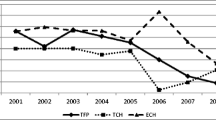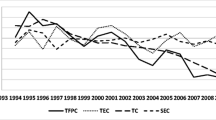Abstract
The water and sewerage industry of England and Wales was privatized in 1989 and subjected to a new regime of environmental, water quality and RPI+K price cap regulation. This paper estimates a quality-adjusted input distance function, with stochastic frontier techniques in order to estimate productivity growth rates for the period 1985–2000. Productivity is decomposed so as to account for the impact of technical change, efficiency change, and scale change. Compared with earlier studies by Saal and Parker [(2000) Managerial Decision Econ 21(6):253–268, (2001) J Regul Econ 20(1): 61–90], these estimates allow a more careful consideration of how and whether privatization and the new regulatory regime affected productivity growth in the industry. Strikingly, they suggest that while technical change improved after privatization, productivity growth did not improve, and this was attributable to efficiency losses as firms appear to have struggled to keep up with technical advances after privatization. Moreover, the results also suggest that the excessive scale of the WaSCs contributed negatively to productivity growth.



Similar content being viewed by others
Notes
This study is concerned only with the industry in England and Wales. Water and sewerage services in Scotland and Northern Ireland remain state owned.
The property of symmetry of the second order terms is imposed in estimation.
In developing the model presented here, we tested a variety of alternative stochastic frontier specifications without fixed effects, but rejected these models given the superiority of the time varying inefficiency model specified here.
This finding is reinforced by noting that the average and median firm specific scale elasticities were respectively 0.886 and 0.863 and 84 percent of these estimates were less than 1.
Since x3 has been used as a numeraire, the labor elasticity can be recovered as \({e_{3}= 1-e_{1}-e_{2}^{.}}\).
Firm specific estimates of technical change are calculated as \({\psi _1 +\psi_2 (t+0.5)+0.5\left[ {(\sum_m^{M-1} {\eta_m \left({\ln {\mathop x\limits^\sim}_{m,i,t} +\ln {\mathop x\limits^\sim}_{m,i,t+1} } \right)} +\sum_k {\kappa_k \left({\ln y_{k,i,t} +\ln y_{k,i,t+1} } \right)} } \right]}\) Given normalization of the data around the sample average, the technical change that would be achieved by a hypothetical unchanging sample average firm can be calculated as ψ1 + ψ2 (t + 0.5).
This conclusion is reinforced by considering the absorption of the water only company Northeast Water, by Northumbrian Water. In the first year after the merger, Northumbrian Water experienced an estimated scale effect of −6.9 percent. This can be interpreted as indicating that Northumbrian Water’s overall TFP fell by almost 7 percent because of the increase in scale resulting from the merger.
References
Bosworth D, Stoneman P (1998) An efficiency study for the water industry, final report: a report to national economic research associates. London, National Economic Research Associates
Bottasso A, Conti M (2004) Regulated competition and cost efficiency in the English and Welsh water industry. mimeo, DIEM Universita di Genova
Caves DW, Christensen LR, Diewert WE (1982) The economic theory of inex numbers and the measurement of input, output, and productivity. Econometrica 50(6):1393–1414
Estache Coelli T, Perelman A, Trujillo SL (2003) A primer on efficiency measurement for utilities and transport regulators. World Bank Institute, Washington, D.C., USA
Coelli T, Perelman S, Romano E (1999) Accounting for environmental influences in stochastic Frontier models: with application to international airlines. J Productivity Anal 11:251–273
Europe Economics (1998) Water and sewerage industries general efficiency and potential for improvement, final report. Europe Economics for Ofwat, London
Fare R, Primont D (1995) Multi-output production duality: theory and applications. Kluwer Academic Publications, Boston
Garcia S, Thomas A (2001) The Structure of Municipal Water Supply Costs: Application to a Panel of French Local Communities. J Productivity Anal 16:5–29
Greene W (2005) Fixed and random effects in stochastic Frontier models. J Productivity Anal 23(7):7–32
Hunt LC, Lynk EL (1995) Privatization and efficiency in the UK water industry: an empirical analysis. Oxford Bull Econ Stat 57(3):371–388
Jaffe A et al. (1995) Environmental regulation and the competitiveness of U.S. manufacturing: what does the evidence tell us. J Econ Literature 33(1):132–163
Ofwat (1996) Report on levels of service for the water industry in England and Wales: 1995–6. Office of Water Services, Birmingham
Ofwat (1999) Final determinations: future water and sewerage charges 2000–05. Office of Water Services, Birmingham
Orea L (2002) Parametric decomposition of a generalized Malmquist productivity index. J Productivity Anal 18(1):5–22
Porter ME (1991) America’s Green Strategy. Scientific Am April:173–181
Saal DS, Parker D (2000) The impact of privatization and regulation on the water and sewerage industry in England and Wales: a translog cost function approach. Managerial and Decision Econ 21(6):253–268
Saal DS, Parker D (2001) Productivity and price performance in the privatized water and sewerage companies of England and Wales. J Regulatory Econ 20(1):61–90
Saal DS, Parker D (2006) Assessing the performance of water operations in the English and Welsh water industry: a lesson in the implications of inappropriately assuming a common frontier. In: Coelli T, Lawrence D (eds) Performance measurement and regulation of network utilities. Edward Elgar Publishing, Cheltenham
Saal D, Reid S (2004) Estimating opex productivity growth in English and Welsh water and sewerage companies: 1993–2003. Aston Business School Working Paper RP0434
Shaoul J (1997) A critical financial analysis of the performance of privatized industries: the case of the water industry in England and Wales. Crit Perspectives Accounting 8:479–505
Stone and Webster Consultants (2004) Investigation into evidence for economies of scale in the water and sewerage industry in England and Wales. Report commissioned and published by the Office of Water Services, Birmingham, UK
Water UK (2000) Waterfacts 2000. London, Water UK
Author information
Authors and Affiliations
Corresponding author
Rights and permissions
About this article
Cite this article
Saal, D.S., Parker, D. & Weyman-Jones, T. Determining the contribution of technical change, efficiency change and scale change to productivity growth in the privatized English and Welsh water and sewerage industry: 1985–2000. J Prod Anal 28, 127–139 (2007). https://doi.org/10.1007/s11123-007-0040-z
Published:
Issue Date:
DOI: https://doi.org/10.1007/s11123-007-0040-z




